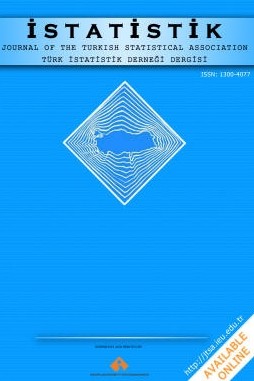A Graphical Tool for Extreme Value Copula Selection Based on the Pickands Dependence Function
A Graphical Tool for Extreme Value Copula Selection Based on the Pickands Dependence Function
Copula, Pickands function Extreme value copula,
___
- Ahmadabadi, A. and Ucer, B.H. (2017). Bivariate nonparametric estimation of the Pickands dependence function using Bernstein copula with kernel regression approach. Computitional Statistics, 32, 1515-1532.
- Brechmann, E.C. (2013). Properties of extreme-value copulas. [Thesis, Technical University of Munich].
- Capéraà, P., Fougres, A.L. and Genest, C. (1997). A nonparametric estimation procedure for bivariate extreme value copulas. Biometrika, 84, 567-577.
- Durante, F., Fernández-Sánchez, J. and Pappad´a, R. (2015). Copulas, diagonals and tail dependence. Fuzzy Sets and Systems, 264, 22-41.
- Dutfoy, A., Parey, S. and Roche, N. (2017). Multivariate extreme value theory-A tutorial with applications to hydrology and meteorology. Dependence Modeling, 2, 30-48.
- Frees, E. and Valdez, E. (1998). Understanding relationships using copulas. North American Actuarial Journal, 2, 1-25.
- Galambos, J. (1975). Order statistics of samples from multivariate distributions. Journal of the American Statistical Association, 70, 674-680.
- Genest, C., Kojadinovic, I., Néslehová, J. and Yan, J. (2011). A goodness-of-fit test for bivariate extremevalue copulas. Bernoulli, 17(1), 253-275.
- Genest, C. and Segers, J. (2009). Rank-Based inference for bivariate extreme value copulas. The Annals of Statistics, 37, 2990-3022.
- Gudendorf, G. and Segers, J. (2011). Nonparametric estimation of an extreme-value copula in arbitrary dimensions. Journal of Multivariate Analysis, 102(1), 37-47.
- Guillotte, S. and Perron, F. (2016). Polynomial pickands functions. Bernoulli, 22(1), 213-241.
- Gumbel, E.J. (1960). Distributios des valeurs extr´emes en plusiers dimensions. Publications de l’Institut de Statistique de l’Université de Paris, 9, 171-173.
- Hougaard, P. (1986). A class of multivariate failure time distributions. Biometrika, 73, 671-678.
- Husler, J. (1986). Extreme values of non-stationary random sequences. Journal of Applied Probability, 23, 937-950.
- Joe, H. (1990). Multivariate concordance. Journal of Multivariate Analysis, 35, 12-30.
- Marcon, G., Padoan, S.A. and Antoniano-Villalobos, I. (2016). Bayesian inference for the extremal dependence. Electronic Journal of Statistics, 10(2), 3310-3337.
- Marcon, G., Padoan, S.A., Naveau, P., Muliere, P. and Segers, J. (2017). Multivariate nonparametric estimation of the Pickands dependence function using Bernstein polynomials. Journal of Statistical Planning and Inference, 183, 1-17.
- Michiels, F. and De Schepper, A. (2013). A new graphical tool for copula selection. Journal of Computational and Graphical Statistics, 22(2), 471-493.
- Pickands, J. (1981). Multivariate extreme value distribution. In Proceedings of the International Statistical Institute, 859-878.
- Sklar, A. (1959). Fonctions de repartition a n dimensions et leurs marges. Publications de lInstitut de Statistique de lUniversite de Paris, 8, 229-231.
- Vettori, S., Huser, R. and Genton, M.G. (2018). A comparison of dependence function estimators in multivariate extremes. Statistics and Computing, 28(3), 525-538.
- ISSN: 1300-4077
- Başlangıç: 1998
- Yayıncı: Başbakanlık
A Lifetime Regression Analysis with Unit Lindley-Weibull Distribution
Ahmet PEKGÖR, Coşkun KUŞ, Kadir KARAKAYA, Buğra SARAÇOĞLU, İsmail KINACI
A Graphical Tool for Extreme Value Copula Selection Based on the Pickands Dependence Function
Generalized Fiducial Inference for the Chen Distribution
A New Computational Approach Based on Density Clustering for Outlier Problems in Linear Models
